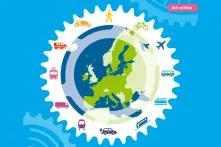
Mobility is not gender neutral. This not only pertains to individual mobility, but also to the transport and planning sectors themselves, which are heavily dominated by men (only 22 per cent of all employees in the transport sector are female). Social stereotypes and role distribution within a predominantly male workforce, as well as care work mostly carried out by females, do the rest to create an environment that is aligned with male needs.

Although this situation is changing slowly, a male and stereotypically technical perspective still dominates today’s mobility. In Germany, for example, 62 per cent of all cars are registered by men, where the “male workforce” typically commutes to work by car.
Women still dominantly carry out the biggest share of care work, meaning that they take more responsibility for organizing family life. This usually goes hand in hand with the transport of shopping and other people, and consequently results in very specific needs regarding accessibility to transport infrastructure. Trip-chaining, the combination of different trips, is more typical for journeys made by women than men and happens closer to home, therefore being more dependent on a good walking and cycling infrastructure. Female mobility is less visible since a considerable share of their work is unpaid, and thus not accounted for by classic means of transport data registration. Female mobility is also more complex than male mobility; as a result, it relies on a functioning multimodal transport system (53 per cent of public transport users in Germany are women, and worldwide the share is even as high as 66 per cent). If a functioning multimodal transport system is not available, a second family car becomes the second best option, at the expense of the environment.
The typical infrastructure of today’s cities is planned around the automobile. The Second World War left Europe destroyed and its cities shattered. Rebuilding took place during a time when the car was gaining prominence. In the sixties, cities no longer “fitted” the car and a rethinking of urban planning became necessary. Cities were planned and rebuilt by a very homogeneous group: working men. European cities were mostly built before motorisation, which meant that as auto mobility spread, taking up space and increasing speed, not only did sidewalks have to be clearly separated from driveways, but cars had to be given much more space.
We grow up in cities that give the car exclusive space, where its owner uses it to work, shop or pursues hobbies. The car is allowed to drive quickly through populated areas - compared to the speed of everyone else moving around town. We take this for granted, like growing up in a forest and perceiving the trees as something that are naturally given. However, the privileges of the car are manmade – and come at the expense of the many.
Even crash test dummies are built based on male anatomy and, if they are used at all, female dummies are usually placed in the passenger seat. As a result, if a woman is involved in a car accident, her risk of suffering injuries is higher than for a man. Objective and subjective safety needs are clearly another concern for female mobility. As well as a car’s safety not being gender neutral, women are forced to walk in a public space that is more dangerous for them than for a man in a car, who simply and safely drives through it in a protective metal shell. When it comes to the removal of snow, for example, roads tend to be prioritised, while the risk of accidents is higher on cycle paths and sidewalks.
When several Swedish cities started clearing sidewalks and cycle paths for the first time, the overall number of injured people decreased. For women the benefit of a means of mobility is not simply as a way to get from A to B, but also in the shaping of the public space. They have different safety needs than men, and they must devise strategies for moving around in public spaces to feel less vulnerable. In the media and in public discussions, women and marginalised people have difficulties participating or being heard with regard to their special needs. This is certainly a reason why there is a significant unawareness of their safety and inclusion needs.
Paris’ Anne Hidalgo and Vienna’s Maria Vassilakou were among the pioneers to create more liveable cities, as they understood that diverse perspectives are needed to create a habitable and inclusive city. The mobility of the future needs to incorporate the needs of all its users (especially the most vulnerable ones), and therefore should be designed by a team that is as diverse as possible, including families, seniors and people with reduced mobility. The privileges of the car, such as the consumption of space, need to be challenged, so that in the end, everybody will profit. If usage-based mobility offers are created, social participation, social justice, and securing livelihoods through services of general interest can all be sustainably secured.
If you want to learn more about women and mobility, check out the green paper on “Gender and (Smart) Mobility”, edited by Marianne Weinreich, author of the European Mobility Atlas 2021 article "Cycling Copenhagen: The Making of a Bike-Friendly City".
Sources for data and graphics: Katharina Klaas, Mobilität von Frauen für Frauen: Warum eine ökologische Verkehrswende auch feministisch sein muss, https://bit.ly/2NUoI89; Publications Office of the European Union, 10.2832/93598, https://bit.ly/3eztdOb

